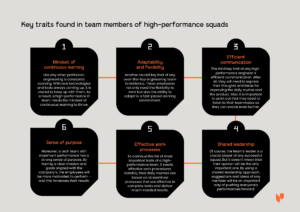The software industry thrives on continuous innovation and adaptation. To stay ahead of the curve, companies need to invest in their most valuable asset: their people. Explore the key Learning and Development (L&D) for software companies, focusing on product, engineering, and support teams.
Here, we’ll explore five L&D programs you can develop in-house:
[ez-toc]1. Job Shadowing: Learning by Seeing
Job shadowing allows employees to gain valuable insights into different roles within the company by observing a colleague performing their day-to-day tasks for an extended period. This can be within their own team or another department.
For example, a product manager might shadow a software engineer to gain a deeper understanding of the development process and the technical considerations behind product features. Through this immersive experience, the product manager can learn new skills and approaches to problem-solving, potentially identifying potential career paths within the company.
- Gain a deeper understanding of different roles and responsibilities.
- Learn new skills and approaches to problem-solving.
- Identify potential career paths within the company.
- Identify learning goals and choose a suitable shadowing partner.
- Schedule clear expectations and communication channels for the shadowing period.
- Encourage a reflective discussion after the shadowing experience.

HR can empower growth in software companies.
2. Performance Shadowing: Upskilling for Success
In performance shadowing, a senior team member observes a colleague performing their role, providing targeted feedback and coaching in real-time. This can be particularly helpful for identifying areas where an employee can improve their performance and develop specific skills.
For example, a senior software developer might shadow a junior developer during a code review session, offering guidance on code best practices and problem-solving techniques. This focused observation and feedback can accelerate the junior developer’s learning and development.
- Identify areas for improvement in an employee’s performance.
- Develop specific skills through targeted coaching and feedback.
- Build stronger mentor-mentee relationships within teams.
- Select a specific task or skill for the shadowing session.
- Create a safe and open environment for feedback.
- Develop a clear action plan after the session with specific goals and resources.

What comes next for software experts? Learn 4 essential skills: adaptability, digital fluency, storytelling & more. Photo by LinkedIn Sales Solutions.
3. Reverse Mentoring: A Two-Way Street
Reverse mentoring pairs senior employees with junior colleagues who can offer their expertise in new technologies or emerging trends. This fosters knowledge exchange across all levels of the organization. For example, a senior product manager might be reverse-mentored by a junior developer with experience in a specific programming language to stay current on industry best practices.
This two-way learning experience benefits both parties – the senior leader gains fresh perspectives, while the junior employee gains valuable exposure and confidence.
- Bridge the generational gap and foster knowledge exchange across all levels.
- Expose senior leadership to fresh perspectives and ideas.
- Empower junior employees and boost their confidence.
- Identify areas where senior leadership can benefit from fresh perspectives.
- Match mentors and mentees based on interests and skillsets.
- Provide clear goals and expectations for the reverse mentoring program.

Inclusive leaders actively create environments where everyone feels valued, respected, and empowered to contribute their unique perspectives. This fosters open communication, psychological safety, and a sense of belonging for all team members. Photo by Brooke Cagle.
4. Leadership Development: Building the Next Generation
Leadership development programs equip employees with the skills and knowledge necessary to take on leadership roles within the company. These programs can include classroom training, online courses, leadership coaching, and rotational assignments in different leadership positions.
For instance, a high-potential product manager might participate in a leadership development program that covers topics such as strategic thinking, team motivation, and effective communication.
- Prepare high-potential employees for future leadership positions.
- Strengthen management capabilities and team dynamics.
- Foster a culture of talent retention and career growth.
- Conduct training needs assessments to identify leadership gaps.
- Develop a curriculum that covers core leadership competencies.
- Offer opportunities for mentees to apply their acquired skills through real-world projects or team leadership roles.

Leadership by example is a powerful way to engage, motivate, and inspire.
5. Succession Planning: Ensuring Continuity
Succession planning is the process of identifying and developing high-potential employees to fill critical roles in the future. This proactive approach minimizes disruption during leadership transitions and ensures the company has qualified individuals to maintain its growth trajectory. For example, a company might identify a talented software engineer with strong leadership potential and provide them with access to targeted training programs and opportunities to gain experience in broader leadership functions.
- Minimize disruption during leadership transitions.
- Ensure the company has qualified individuals to maintain its growth trajectory.
- Boost employee morale and engagement by demonstrating commitment to career development.
- Conduct skills gap analysis to identify future leadership needs.
- Create a talent pool of high-potential employees with clear development plans.
- Regularly review succession plans and update them based on changes in business needs.
Investing in Your People Pays Off: Learning and Development For The Win!
Studies by LinkedIn Learning show that companies with strong L&D programs experience 24% higher employee retention rates. By investing in these L&D strategies, software companies can empower their product, engineering, and support teams to reach their full potential, driving innovation and long-term success.

Key traits in members of high-performance squads
At Ubiminds, we firmly believe that continuous learning and development are the cornerstones of a thriving software development team. By implementing these L&D strategies, you can equip your product, engineering, and support teams with the skills and knowledge they need to stay ahead of the curve and deliver exceptional results.
Empowering Our Team Through L&D
We don’t just preach L&D, we live it! Ubiminds actively sponsors training programs and event participation for our team members, ensuring they have access to the latest industry knowledge and best practices. This commitment to continuous learning fosters a culture of innovation and excellence within our company.
Ready to Build a High-Performing Team?
Ubiminds offers a range of software development services to help your company achieve its goals. Our team of skilled and passionate developers, backed by a strong foundation in L&D principles, can deliver innovative solutions that drive success. Contact us today to learn more!

International Marketing Leader, specialized in tech. Proud to have built marketing and business generation structures for some of the fastest-growing SaaS companies on both sides of the Atlantic (UK, DACH, Iberia, LatAm, and NorthAm). Big fan of motherhood, world music, marketing, and backpacking. A little bit nerdy too!


